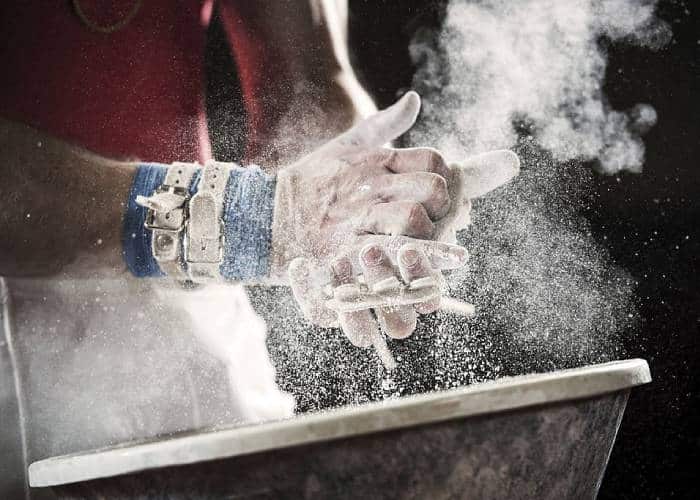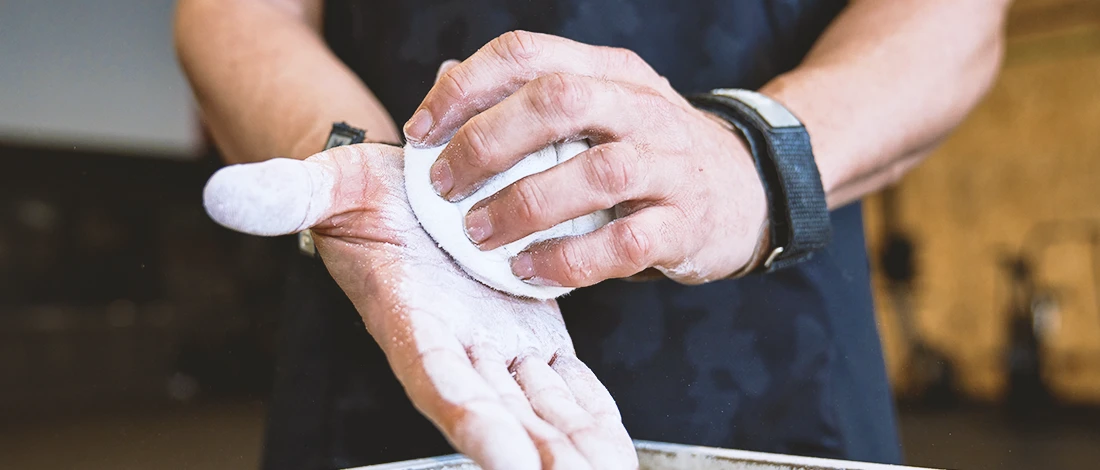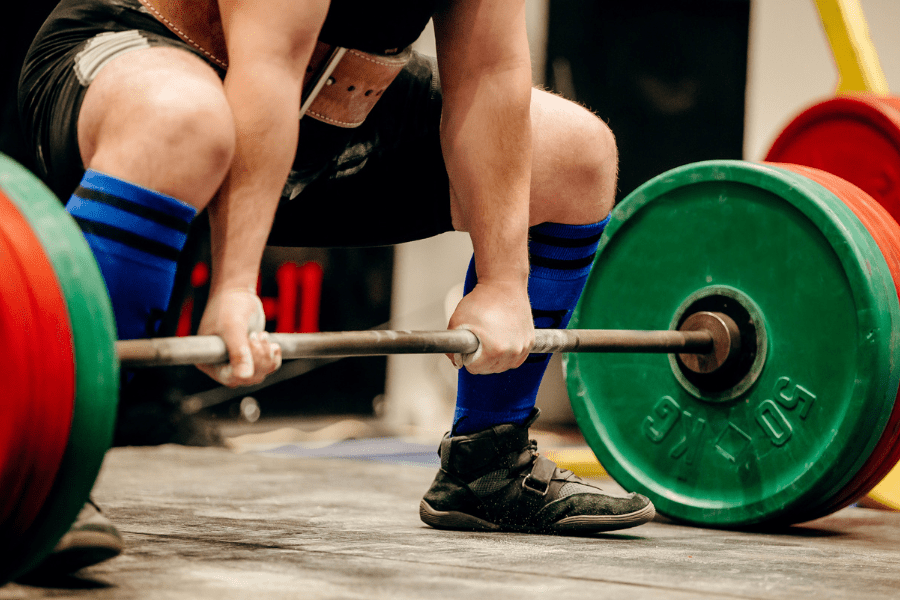Have you ever wondered what exactly makes up the white powder that gym-goers often dust their hands with before a workout? Well, today we’re going to dive into the fascinating world of gym chalk and explore the ingredients that make it up. Whether you’re a seasoned athlete or just getting started on your fitness journey, understanding what goes into your gym chalk can help you make more informed choices about the products you use.
So, what is gym chalk made of? The main ingredient in gym chalk is actually magnesium carbonate, a fine white powder that has excellent gripping properties. This is why it’s commonly used by athletes and weightlifters to improve their grip on equipment such as barbells and pull-up bars.
Magnesium carbonate absorbs moisture from the skin, reducing the chances of slipping or losing control during exercise. In addition to magnesium carbonate, gym chalk may also contain a small amount of additives such as drying agents or fragrances to enhance its performance or scent.
Now that we’ve covered the basics, let’s delve deeper into the world of gym chalk and discover more about its ingredients and benefits. In the upcoming article, we’ll explore the different types of gym chalk available, discuss the benefits of using gym chalk, and provide some tips on how to choose the best gym chalk for your needs. Get ready to master your grip and take your workout to the next level!

What is gym chalk?
Gym chalk, also known as magnesium carbonate chalk, is a white powdery substance that is commonly used in gymnasiums and sports facilities. It is composed of several ingredients that work together to improve grip and prevent slipping. Gym chalk is usually sold in a block or powder form and can be applied directly onto the hands or equipment.
Importance of gym chalk
The use of gym chalk is crucial for athletes and fitness enthusiasts as it enhances their performance and safety during workouts. By reducing moisture and sweat on the hands, gym chalk prevents slipping and improves grip, allowing individuals to hold onto equipment securely. This is especially vital for activities that require a strong grip, such as weightlifting or rock climbing, where a loss of grip could lead to accidents and injuries.
In addition to providing a better grip, gym chalk also helps to promote hygiene in gym environments. By absorbing the sweat and oil from the hands, it reduces the chances of bacteria growth and prevents the spread of germs among users. This is particularly important in shared gym spaces where multiple individuals may be using the same equipment.
Magnesium Carbonate
Magnesium carbonate is the primary ingredient in gym chalk. It is a naturally occurring white mineral that has excellent moisture-absorbing properties. Magnesium carbonate is widely used in the production of chalk due to its ability to provide a dry and grippy surface when applied to the hands.
Properties of magnesium carbonate
Magnesium carbonate is an odorless and tasteless compound. It is insoluble in water, making it an ideal choice for gym chalk as it maintains its dry form even in humid conditions. This property allows athletes to maintain a firm grip on equipment, even when sweating heavily.
Benefits of using magnesium carbonate in gym chalk
The use of magnesium carbonate in gym chalk offers several benefits to athletes and fitness enthusiasts. Firstly, it provides a strong and reliable grip, enhancing performance during weightlifting, rock climbing, and other activities that require a secure hold. With improved grip, athletes can focus on their technique and execution without worrying about slipping or losing their grip.
Additionally, magnesium carbonate chalk absorbs moisture and sweat effectively, keeping the hands dry throughout the workout. This is crucial for activities that involve repetitive movements or prolonged periods of physical exertion, as it minimizes the chances of hands becoming slippery and reduces the risk of accidents or injuries.
Alternatives to magnesium carbonate
While magnesium carbonate is the most common ingredient used in gym chalk, some individuals may have allergies or sensitivities to it. In such cases, alternatives to magnesium carbonate can be used. One popular alternative is calcium carbonate.

Calcium Carbonate
Calcium carbonate, like magnesium carbonate, is a naturally occurring mineral commonly used in the production of gym chalk. It shares many properties with magnesium carbonate and serves as an effective substitute for individuals who cannot use magnesium carbonate due to allergies or sensitivities.
Properties of calcium carbonate
Calcium carbonate is a white, odorless, and tasteless compound that is also insoluble in water. It has similar moisture-absorbing properties to magnesium carbonate, making it an ideal ingredient in gym chalk for maintaining a dry and grippy surface.
Benefits of using calcium carbonate in gym chalk
The use of calcium carbonate in gym chalk offers similar benefits as magnesium carbonate. It provides a reliable grip, absorbs moisture and sweat, and enhances performance during physical activities. Individuals who are allergic to magnesium carbonate can use calcium carbonate chalk without compromising their grip or safety.
Comparison of calcium carbonate and magnesium carbonate
While both magnesium carbonate and calcium carbonate are effective ingredients in gym chalk, there are slight differences between the two. Magnesium carbonate generally provides a stronger grip than calcium carbonate. However, calcium carbonate tends to be gentler on the skin and is less likely to cause irritation or dryness. The choice between the two ultimately depends on personal preference and any allergies or sensitivities an individual may have.
Silica
Silica is another ingredient that is sometimes used in gym chalk formulations. It is a naturally occurring compound found in rocks, sand, and various minerals. Silica plays a different role in gym chalk compared to magnesium carbonate or calcium carbonate.
Properties of silica
Silica is a hard, crystalline compound that is highly absorbent and abrasive. It has a high melting point and is resistant to moisture, making it suitable for use in gym chalk.
Role of silica in gym chalk
Silica is often added to gym chalk to increase its abrasiveness. The abrasive nature of silica helps to enhance the grip by increasing the friction between the skin and the equipment or surface. This can be beneficial for individuals who require an extra level of grip, such as pole dancers or rock climbers.
Risks associated with using silica in gym chalk
While the use of silica in gym chalk can improve grip and performance, it is important to note that prolonged exposure to silica dust can be detrimental to health. Breathing in silica dust can lead to respiratory issues and lung diseases, particularly in high concentrations or over extended periods of time. Therefore, it is essential to use gym chalk with silica in a well-ventilated area and minimize inhalation of the dust.

Other Additives
In addition to the main ingredients mentioned above, gym chalk may also contain various additives that serve different purposes.
Purpose of additives in gym chalk
Additives are often included in gym chalk formulations to enhance its grip, texture, and durability. These additives can vary depending on the brand and manufacturer, but their overall goal is to improve the performance of the chalk.
Common additives used in gym chalk
One common additive found in gym chalk is rosin, a resinous substance obtained from pine trees. Rosin is known for its tacky properties, which can further enhance the grip provided by gym chalk. Other additives may include drying agents, such as talc or baking soda, which help to absorb moisture and maintain a dry surface.
Effect of additives on grip and texture
The inclusion of additives can have a significant impact on the grip and texture of gym chalk. For example, the addition of rosin can increase the stickiness and tackiness of the chalk, providing an even stronger grip. On the other hand, the use of drying agents may result in a drier and less powdery texture.
Different Forms of Gym Chalk
Gym chalk is available in different forms, each offering its own advantages and disadvantages. The most common forms of gym chalk include loose chalk, chalk balls, and liquid chalk.
Loose chalk
Loose chalk is the traditional form of gym chalk, usually sold in a powdered or block form. It can be directly applied to the hands or equipment, providing maximum coverage and grip. Loose chalk allows for precise application and is favored by many athletes for its versatility. However, loose chalk can be messy and may require frequent reapplication during intense workouts.
Chalk balls
Chalk balls are a popular alternative to loose chalk, particularly in environments where cleanliness is prioritized. Chalk balls are small, porous bags filled with powdered chalk. They allow for controlled and less messy application, as the chalk is contained within the bag. Chalk balls are convenient to use and minimize the amount of dust in the air, making them a preferred choice for indoor gym settings.
Liquid chalk
Liquid chalk is a relatively new form of gym chalk that has gained popularity in recent years. It is a suspension of powdered chalk in an alcohol-based solution. Liquid chalk offers a mess-free and long-lasting grip solution. The liquid formula dries quickly upon application, leaving a thin layer of chalk on the hands, which provides a consistent grip throughout the workout. Liquid chalk is particularly useful in situations where reapplication of traditional chalk is inconvenient or during activities that involve frequent hand contact with surfaces.

Pros and Cons of Gym Chalk
While gym chalk offers numerous benefits for athletes and fitness enthusiasts, it is important to consider both the advantages and disadvantages before incorporating it into your routine.
Benefits of using gym chalk
The primary benefit of using gym chalk is improved grip and control. Gym chalk absorbs moisture, keeping the hands dry and preventing slipping. This allows athletes to maintain a secure hold on equipment, reducing the risk of accidents and injuries. Gym chalk also promotes hygiene by absorbing sweat and oil, minimizing the chances of bacteria growth and the spread of germs in gym environments.
Disadvantages of using gym chalk
One of the main disadvantages of gym chalk is that it can be messy, especially in its loose form. The powder can spread and create dust particles, which may cause breathing discomfort for some individuals. Additionally, loose chalk may require frequent reapplication during intense workouts, which can be inconvenient and time-consuming. Another consideration is that some gyms have regulations or restrictions on the use of gym chalk due to cleanliness concerns.
Regulations and restrictions on gym chalk use
It is important to familiarize yourself with the regulations and policies regarding gym chalk use in your specific gym or training facility. Some establishments may have restrictions on the type of chalk allowed or require certain clean-up procedures to minimize dust and mess. It is always best to check with the gym management to ensure compliance with their guidelines.
Proper Application and Storage
To maximize the benefits of gym chalk and maintain its effectiveness, proper application and storage are crucial.
How to apply gym chalk effectively
When applying gym chalk, make sure your hands are clean and dry. Simply rub the chalk onto your palms, fingers, and any other areas that require grip. Ensure even coverage and distribution of the chalk to achieve the desired level of grip. It is important not to overdo it, as excessive chalk can become ineffective or create unnecessary mess.
Guidelines for storing gym chalk
Proper storage of gym chalk is essential to preserve its quality and prevent it from becoming damp or unusable. Store gym chalk in a cool and dry place, away from direct sunlight or moisture. It is recommended to keep the chalk in a sealed container or bag to protect it from humidity, which can affect its performance.
Preventing contamination and moisture
To prevent contamination and moisture buildup, avoid sharing your personal chalk with others. Sweat and oil from different individuals can affect the performance and consistency of the chalk. Additionally, it is essential to keep gym chalk away from damp surfaces or liquids that can cause it to clump or lose its grip-enhancing properties.

Alternatives to Traditional Gym Chalk
While traditional gym chalk is widely used and effective, there are alternatives available for individuals with specific needs or preferences.
Liquid grip products
Liquid grip products have emerged as an alternative to traditional gym chalk. These products are typically made from a combination of alcohol and rosin, providing a tacky grip similar to that of gym chalk. Liquid grip products usually come in a bottle with an applicator, allowing for controlled application and minimizing mess. They can offer a longer-lasting grip compared to traditional chalk and are ideal for individuals who find loose chalk messy or inconvenient to use.
Gym chalk alternatives for sensitive skin
For individuals with sensitive skin or allergies to the main ingredients in gym chalk, there are several alternatives available. Some options include using special hypoallergenic chalk formulations or using grip aids such as gloves or finger tape. These alternatives help individuals maintain a secure grip without causing irritation or discomfort.
Environmental-friendly options
In recent years, there has been a growing awareness of the environmental impact of gym chalk. Traditional gym chalk often contains chemicals that may negatively impact the environment, particularly when disposed of improperly. As a result, some brands have introduced eco-friendly gym chalk options that utilize natural and biodegradable ingredients. These alternatives provide a similar level of grip while being more environmentally conscious.
Conclusion
Gym chalk is a valuable tool for athletes and fitness enthusiasts, offering enhanced grip, improved performance, and reduced risk of accidents. Understanding the ingredients used in gym chalk is essential for making an informed choice when selecting the right product for your needs.
Magnesium carbonate is the primary ingredient in gym chalk, providing a dry and grippy surface. Calcium carbonate is a suitable alternative for individuals with allergies or sensitivities to magnesium carbonate.
Silica is sometimes included in gym chalk to enhance grip through its abrasive properties, but caution should be exercised to minimize the risk of inhaling silica dust.
Various additives can improve the grip and texture of gym chalk, and different forms such as loose chalk, chalk balls, and liquid chalk offer distinct advantages and convenience.
It is important to consider the pros and cons of gym chalk, along with any regulations or restrictions in your gym or training facility. Proper application and storage practices will help maintain the effectiveness of gym chalk and prevent contamination.
For individuals with specific needs or preferences, alternatives such as liquid grip products, gym chalk for sensitive skin, and environmentally-friendly options are available. Ultimately, choosing the right gym chalk is a personal decision that should prioritize safety, performance, and individual preferences.




